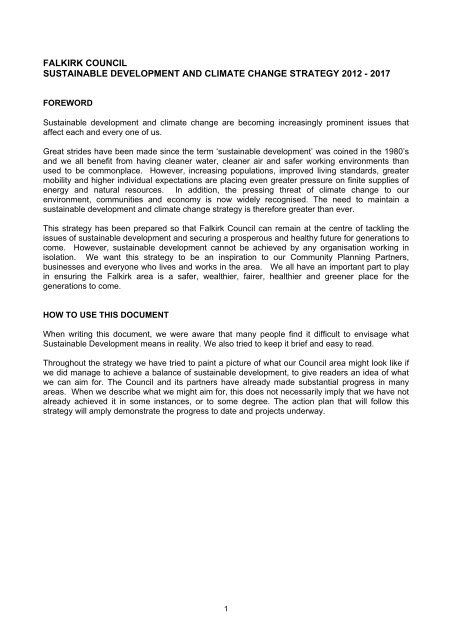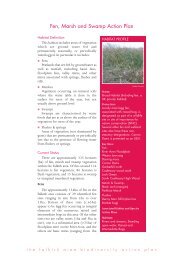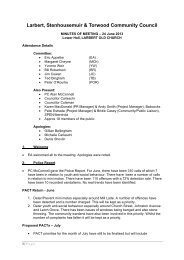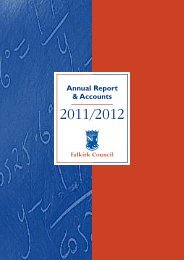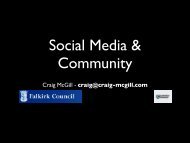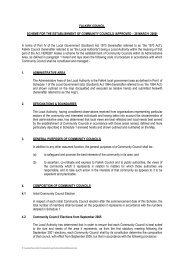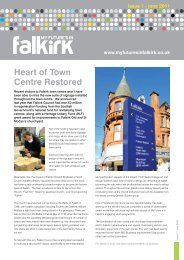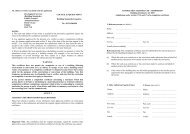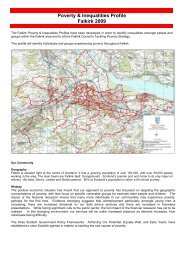Sustainable Development & Climate Change Strategy - Falkirk Council
Sustainable Development & Climate Change Strategy - Falkirk Council
Sustainable Development & Climate Change Strategy - Falkirk Council
Create successful ePaper yourself
Turn your PDF publications into a flip-book with our unique Google optimized e-Paper software.
FALKIRK COUNCIL<br />
SUSTAINABLE DEVELOPMENT AND CLIMATE CHANGE STRATEGY 2012 - 2017<br />
FOREWORD<br />
<strong>Sustainable</strong> development and climate change are becoming increasingly prominent issues that<br />
affect each and every one of us.<br />
Great strides have been made since the term ‘sustainable development’ was coined in the 1980’s<br />
and we all benefit from having cleaner water, cleaner air and safer working environments than<br />
used to be commonplace. However, increasing populations, improved living standards, greater<br />
mobility and higher individual expectations are placing even greater pressure on finite supplies of<br />
energy and natural resources. In addition, the pressing threat of climate change to our<br />
environment, communities and economy is now widely recognised. The need to maintain a<br />
sustainable development and climate change strategy is therefore greater than ever.<br />
This strategy has been prepared so that <strong>Falkirk</strong> <strong>Council</strong> can remain at the centre of tackling the<br />
issues of sustainable development and securing a prosperous and healthy future for generations to<br />
come. However, sustainable development cannot be achieved by any organisation working in<br />
isolation. We want this strategy to be an inspiration to our Community Planning Partners,<br />
businesses and everyone who lives and works in the area. We all have an important part to play<br />
in ensuring the <strong>Falkirk</strong> area is a safer, wealthier, fairer, healthier and greener place for the<br />
generations to come.<br />
HOW TO USE THIS DOCUMENT<br />
When writing this document, we were aware that many people find it difficult to envisage what<br />
<strong>Sustainable</strong> <strong>Development</strong> means in reality. We also tried to keep it brief and easy to read.<br />
Throughout the strategy we have tried to paint a picture of what our <strong>Council</strong> area might look like if<br />
we did manage to achieve a balance of sustainable development, to give readers an idea of what<br />
we can aim for. The <strong>Council</strong> and its partners have already made substantial progress in many<br />
areas. When we describe what we might aim for, this does not necessarily imply that we have not<br />
already achieved it in some instances, or to some degree. The action plan that will follow this<br />
strategy will amply demonstrate the progress to date and projects underway.<br />
1
1 INTRODUCTION<br />
This document updates the <strong>Council</strong>’s <strong>Sustainable</strong> <strong>Falkirk</strong> <strong>Strategy</strong> 2006 – 2011 which<br />
successfully promoted sustainable development throughout the <strong>Falkirk</strong> <strong>Council</strong> area during<br />
this period. The main aims of that strategy were to achieve a healthier environment, a<br />
more prosperous economy and inclusive society. In 2012 these aims are as relevant as<br />
ever. This revised strategy further commits <strong>Falkirk</strong> <strong>Council</strong> to putting sustainable<br />
development and dealing with climate change at the centre of everything it does. It also<br />
sets out the <strong>Council</strong>’s responsibilities for actions it can implement directly and areas that<br />
the <strong>Council</strong> can influence by enabling others within the wider community.<br />
Early discussions with the public suggested that they find it difficult to imagine what a<br />
sustainably developed area might look like. We picked out the Scottish Government’s five<br />
priorities and, in each section, listed examples of actions or values that describe what our<br />
area might look like if we reach those goals. They also reported that they found some policy<br />
documents to be ‘dry’ and full of jargon. We have tried to keep this document as concise<br />
and as clear as possible.<br />
This strategy has been developed by the <strong>Council</strong> through consultation with its community<br />
planning partners, partner organisations and public consultation. Consultees will also be<br />
invited to contribute actions to the <strong>Sustainable</strong> <strong>Development</strong> and <strong>Climate</strong> <strong>Change</strong> Action<br />
Plan that will result from this strategy. Actions will have clear targets and timescales with a<br />
constant revision process and progress reported annually through the committee process.<br />
1.1 WHO WILL IMPLEMENT THIS STRATEGY?<br />
We are all affected by the impacts of climate change and unsustainable forms of<br />
development, whether it is through rising fuel bills, loss of biodiversity or local traffic<br />
congestion. The strategy is therefore intended to be implemented by a wide range of<br />
community interests:<br />
<strong>Council</strong> Elected Members and officers - by applying the policies and principles of<br />
sustainable development and climate change set out in the strategy.<br />
Community Planning partners - by signing up to these principles both as a basis for<br />
partnership working and in undertaking their own activities.<br />
Community groups, businesses and individuals – by increasing awareness of how<br />
sustainable development and climate change can be placed at the centre of everything they<br />
do.<br />
1.2 WHAT IS SUSTAINABLE DEVELOPMENT ?<br />
The concept of sustainable development goes back over 20 years. In 1987 the World<br />
Commission on Environment and <strong>Development</strong> published the report “Our Common Future”<br />
which sought to find a way forward that tackled the need to address development as well as<br />
environmental protection. The Commission coined the term, ‘sustainable development’ and<br />
defined it as,<br />
“<strong>Development</strong> that meets the needs of the present, without compromising the ability of<br />
future generations to meet their own needs.”<br />
In the past development was synonymous with commerce, new housing, infrastructure and<br />
industry. Making a profit often was at the expense of living conditions, social justice, health<br />
and the environment. However, it is now widely recognised and accepted that material<br />
2
consumption only contributes to wellbeing up to a point and that quality of life depends on<br />
social and environmental improvement as well as economic growth. A strong economy<br />
needs a strong society, and both of these depend on a healthy environment – see Figure 1.<br />
<strong>Sustainable</strong> development is about integrating social, economic and environmental<br />
considerations, and achieving balance between the population’s requirements and the<br />
carrying capacity (see glossary) of the environment. Finding solutions that achieve this<br />
"win-win" outcome is not straightforward and requires an approach that challenges previous<br />
thinking and changes the way that things are done at present.<br />
Economy<br />
A strong resilient<br />
economy supporting and<br />
supported by…………….<br />
Society<br />
sustainable communities,<br />
set in a …………………….<br />
Environment<br />
protected and<br />
enhanced<br />
environment<br />
Figure 1 – Strong <strong>Sustainable</strong> <strong>Development</strong><br />
Diagram based on Scottish Government Theories and Principles for <strong>Sustainable</strong><br />
<strong>Development</strong><br />
1.3 WHAT IS CLIMATE CHANGE ?<br />
<strong>Climate</strong> is the average weather experienced over a long period. <strong>Climate</strong> change is said to<br />
be occurring when average temperature, precipitation, wind etc. differ significantly from<br />
previous average conditions and are seen to endure, bringing about corresponding<br />
changes in weather, ecosystems and socio-economic activity. <strong>Climate</strong> change due to<br />
human activity is a step beyond this and is the most extreme manifestation of unsustainable<br />
development. Its impacts are now widely recognised at a local and global scale. As the<br />
volume of greenhouse gases (see glossary) from industrial, domestic and vehicle<br />
emissions issuing into the atmosphere continues at unprecedented rates, severe weather<br />
events have become more commonplace.<br />
1.4 HASN’T THE EARTH’S CLIMATE ALWAYS CHANGED ?<br />
3
Yes it has. The Earth’s climate is not fixed, and in the past has changed many times in<br />
response to a variety of natural causes. Ecosystems have changed and adapted in<br />
response. The issue in the 21 st century is climate change caused by human activities.<br />
Problems arise when the climate changes more quickly than ecosystems and communities<br />
can adapt.<br />
1.5 IS CLIMATE CHANGE SCIENCE SOUND ?<br />
Yes it is. The United Nation’s Intergovernmental Panel on <strong>Climate</strong> <strong>Change</strong> (IPCC) is<br />
considered the world’s definitive authority on the subject. In 2010 it noted:<br />
“Globally, average temperatures have increased by 0.6 degrees centigrade since 1860 in<br />
the northern hemisphere. However the temperature increase during the 20th century was<br />
greater than during any other century in the last millennium, with the 1990s being the<br />
warmest decade of the millennium. The probable temperature rise by the end of this<br />
century will be between 1.8 and 4 degrees centigrade.<br />
Sea levels have been increasing by one to two millimetres each year and are likely to rise<br />
between 28 and 43 centimetres by the end of this century. In the northern hemisphere, bird<br />
arrival, plant flowering, the animal breeding season and the arrival of insects is occurring<br />
earlier in the year. Tropical storms and extreme flooding are becoming more frequent.”<br />
1.6 WHAT COULD CLIMATE CHANGE MEANS FOR US ?<br />
In the UK we are likely to experience changes to weather patterns, rising sea levels and<br />
increased frequency and intensity of extreme weather events, including ‘storminess’ and<br />
associated risks of flash flooding. The severe cold and snow of December 2010 in central<br />
Scotland may or may not have been directly attributable to climate change, but did provide<br />
a graphic example of the disruption which severe weather can cause to transport networks,<br />
local infrastructure, social services and fuel supplies.<br />
4
2 SUSTAINABLE DEVELOPMENT & CLIMATE CHANGE – CONTEXT<br />
2.1 NATIONAL CONTEXT<br />
The UK Government published its first national sustainable development strategy in 1994.<br />
This was updated in 2005 with the publication of “Securing the Future: Delivering UK<br />
<strong>Sustainable</strong> <strong>Development</strong> <strong>Strategy</strong>”. This identified a key role for the public sector,<br />
particularly devolved and local government. This was to be achieved through consideration<br />
and review of their own practices and policies and as facilitators, enablers and educators<br />
over matters they may be able to influence, even though these may not be within their<br />
direct control.<br />
It also set out five key sustainability principles which now form the strategic basis for<br />
sustainable development in the UK. The diagram below has been taken from the UK<br />
Sustainability <strong>Strategy</strong> and sets out these principles.<br />
Achieving a<br />
<strong>Sustainable</strong><br />
Economy<br />
(Full version in Appendix 1).<br />
Living Within Ensuring a<br />
Environmental<br />
Limits<br />
Promoting<br />
Good<br />
Governance<br />
Strong, Healthy<br />
& Just Society<br />
Using Sound<br />
Science<br />
Responsibly<br />
The relationship between national principles and the vision and aims of this strategy not<br />
only enables the strategy to focus on what is right for the <strong>Falkirk</strong> <strong>Council</strong> area, but also<br />
ensures that we are making a meaningful contribution to national sustainability objectives.<br />
The above principles underpin the central theme in this strategy: that a good quality of life<br />
for all can only be achieved if we recognise that economic, environmental and social<br />
requirements are inextricably linked. The successful delivery of sustainability also depends<br />
on good governance at national and local levels and making responsible use of the latest<br />
thinking in the development of policies, initiatives and projects.<br />
2.2 SCOTTISH CONTEXT - WHAT ARE FALKIRK COUNCIL’S OBLIGATIONS ?<br />
<strong>Falkirk</strong> <strong>Council</strong> has a responsibility under the Local Government in Scotland Act 2003 to,<br />
“discharge its duties … in a way which contributes to the achievement of sustainable<br />
development”.<br />
Best value guidance (see glossary) makes it clear that there should be commitment at<br />
elected Member and senior officer level to contribute to achieving sustainable development.<br />
This should be reflected in the <strong>Council</strong>’s strategies, policies and plans. The guidance also<br />
requires that these are informed by the views of its communities and Community Planning<br />
partners (see glossary). These partners include Central Scotland Police, Central Scotland<br />
Fire and Rescue Service and Forth Valley College, Transition Town Grangemouth, CVS<br />
<strong>Falkirk</strong> & District etc. A full list of partners is given in Appendix 2. Best value also places<br />
emphasis on measuring improvements in quality of life and reporting on this.<br />
5
The <strong>Climate</strong> <strong>Change</strong> (Scotland) Act 2009 looks at the role of public bodies and has made it<br />
a legal obligation for them to build climate change and sustainable development into all of<br />
their work. The Act is the world’s most ambitious climate change legislation, introducing a<br />
headline target of reducing greenhouse gas emissions by 80 per cent by 2050, with an<br />
interim target of 42 per cent by 2020. The Scottish Government’s delivery plan for achieving<br />
these ambitious targets envisages largely carbon neutral (see glossary) electricity<br />
generation by 2020, primarily carbon neutral heating for buildings by 2050, and the almost<br />
complete decarbonisation of road transport by 2050.<br />
The full legislative framework guiding sustainable living and climate change mitigation and<br />
adaptation, is set out in Appendix 3.<br />
This strategy will look at how <strong>Falkirk</strong> <strong>Council</strong> can meet its obligations and help elected<br />
Members, officers, Community Planning partners, community organisations and local<br />
people understand what they can do to contribute. The vision and aims included in this<br />
strategy, and how the <strong>Council</strong> intends to achieve these will be developed in a Sustainability<br />
and <strong>Climate</strong> <strong>Change</strong> Action Plan and Carbon Management Plan (see glossary), along with<br />
targets and indicators of progress.<br />
6
3 THE STRATEGIC VISION AND AIMS<br />
3.1 SUSTAINABILITY REQUIREMENTS<br />
For development to be truly sustainable it must:<br />
Be concerned with the integration of social, economic and environmental objectives and not<br />
with trading advantages in one sphere against losses in another.<br />
Recognise the impacts that decisions taken locally will have on global concerns.<br />
Recognise the impacts that decisions taken now will have on generations in the future.<br />
Place a high emphasis on public engagement in decisions that affect them.<br />
Consequently our STRATEGIC VISION for the future is:<br />
A <strong>Falkirk</strong> <strong>Council</strong> area where the sustainable use of resources and partnership<br />
working has resulted in economically and socially vibrant communities living in a<br />
flourishing natural environment.<br />
The central STRATEGIC AIMS will be:<br />
To improve <strong>Falkirk</strong> <strong>Council</strong>’s own performance with regard to its sustainable development<br />
and climate change duties.<br />
To support and encourage the efforts of Community Planning partners and local people in<br />
tackling the issues of sustainable development and climate change.<br />
To pursue goals, indicators and targets for continuous improvement, which can be<br />
monitored, reviewed and revised as conditions change.<br />
The environmental impacts of this strategy have been assessed and are documented in the<br />
accompanying strategic environmental assessment (SEA) report. The SEA has been<br />
prepared using a methodology which predicts and assesses the impact of plans,<br />
programmes and strategies on the environment.<br />
3.2 HOW ARE WE GOING TO TACKLE THE STRATEGY ?<br />
By considering the UK Government’s five key sustainability principles - living within<br />
environmental limits, ensuring a strong healthy and just society, achieving a sustainable<br />
economy, promoting good governance, and using sound science responsibly - we have<br />
identified a framework for action which will take forward the above strategic vision and<br />
aims.<br />
3.2.1 Living within environmental limits<br />
Locally and globally we are already “living beyond our means” and material consumption is<br />
out of balance with long term ecological sustainability. Increasing populations, improved<br />
living standards, greater mobility and higher individual expectations are placing even<br />
greater pressure on natural resources. If we don’t live within the carrying capacity of our<br />
environment, then we will not only jeopardise our economic prosperity and quality of life,<br />
but also the ecological systems on which we depend for our survival. We shall also deplete<br />
the stock of natural resources for future generations.<br />
7
In order to ensure that we live within our means, we must establish what resources we<br />
currently use and how much we should use. Ecological foot printing can help with this. Your<br />
ecological footprint is a measure of how much of the planet’s natural resources – farmland,<br />
forest, minerals, oil, fresh water and sea would be needed to produce the goods and<br />
services for you to live your lifestyle. Globally people are using about 25% more than the<br />
planet can replace and, in the UK, we’re consuming three times our fair share. One of the<br />
greatest impacts on the environment and principal causes of climate change are carbon<br />
emissions from burning of fossil fuels (see glossary) to produce energy for heating,<br />
manufacturing and transportation. If we can reduce demand in all these areas we can use<br />
our natural resources more sustainably.<br />
What would the <strong>Falkirk</strong> <strong>Council</strong> area be like if we did live within our environmental limits ?<br />
It would be an area where the amount of energy used, especially in heating and lighting our<br />
homes, work places and public spaces would be minimised. Increasing the thermal<br />
efficiency of our homes will reduce energy waste and energy demand which can assist in<br />
the reduction of fuel poverty levels (though will not eradicate it when fuel prices remain<br />
high).<br />
Car use, particularly one person per car on the daily commute, would decrease. Public<br />
transport, car sharing, cycling and walking would become more common.<br />
Energy would be generated locally, from an appropriate network of renewable energy (see<br />
glossary) generators, using a variety of technologies. Communities, public bodies and<br />
businesses would set up these renewable energy sources, selling any excess to make<br />
profit for the local economy.<br />
Recycling and reclamation of valuable metals and chemicals from all our gadgets, cars and<br />
disposable items would be maximised. Dumping of waste in landfill would eventually<br />
become a thing of the past. Upgrading and repairing items instead of replacing would<br />
eventually once again be commonplace.<br />
A lot more of the food we eat would be produced locally.<br />
How can we achieve this?<br />
By producing a <strong>Falkirk</strong> <strong>Council</strong> carbon management plan with targets and time-scales, to<br />
achieve a significant reduction in greenhouse gas emissions from our own operations.<br />
By working with young people, communities, businesses and projects such as Transition<br />
Town Grangemouth (see glossary) to raise awareness of ecological footprinting to enable<br />
them to work out what things they can change and influence.<br />
By publicising the results of Low CO2 Vehicles Project with hybrid vehicles trialed by <strong>Falkirk</strong><br />
<strong>Council</strong> and Central Scotland Police to show the benefits, and drawbacks, of these.<br />
By continuing to develop work with school communities to get parents and school staff to<br />
choose alternatives to the car, with walking buses and by co-ordinating lifts.<br />
By using advances in information technology to share school resources.<br />
By ensuring that all planning permission related Travel Plans are implemented and<br />
monitored.<br />
8
By encouraging large local employers to cut the mileage that their fleet vehicles travel by<br />
carefully planning routes and by setting targets to cut staff travel.<br />
By providing facilities for and encouraging use of conference calls and video conferencing.<br />
By continuing programmes to improve building fabric, insulation and heating systems.<br />
By moving away from a disposable society and lobbying manufacturers to produce items<br />
that are designed to allow upgrade and repair and amending procurement policies to favour<br />
these.<br />
By purchasing re-used, recycled furniture.<br />
By using Government Buying Standards in all relevant procurement activities.<br />
By improving air and water quality and using water more efficiently.<br />
By improving soil quality and promoting sustainable agriculture and forestry.<br />
By promoting and increasing biodiversity, and extending care for designated nature areas,<br />
habitat networks and green spaces.<br />
By improving the quality and quantity of open space.<br />
By understanding how our natural systems can be valued more in terms of their<br />
contribution to managing flood risk.<br />
By accelerating climate change adaptation (see glossary) in the <strong>Falkirk</strong> area.<br />
By encouraging allotment provision throughout the <strong>Council</strong> area and the production of<br />
locally grown food.<br />
By maintaining and extending a <strong>Council</strong>-wide footpath/ cycling network.<br />
3.2.2 Achieving a sustainable economy<br />
Economic development used to go hand in hand with environmental damage and the<br />
exploitation of communities. <strong>Sustainable</strong> development improves the environment whilst<br />
boosting economies and supporting communities. In times where we are seeing energy<br />
prices escalate and demand surge from new industrial nations our economy faces threats<br />
and also opportunities. The potential for green jobs (see glossary) is becoming a reality,<br />
with more and more people moving from landfilling to recycling, energy from waste projects,<br />
renewable energy and green tourism. The <strong>Falkirk</strong> <strong>Council</strong> area’s strong industrial past<br />
presents the opportunity for a green industrial future.<br />
What would a sustainable <strong>Falkirk</strong> <strong>Council</strong> area economy be like?<br />
It would be an area where none of its waste goes direct into landfill - a target date of 2050<br />
has been set by the Scottish Government for this. The area would have facilities to recover<br />
large quantities of waste resources to resell, and would use any left over to generate<br />
energy. Continuous commitment to the Waste Hierarchy will continue to be the key<br />
9
Existing industrial expertise would have installed renewable technologies, in the right<br />
locations, allowing the <strong>Council</strong> area to reduce its carbon footprint and increase fuel security<br />
whilst decreasing its reliance on fuel sources with a large ecological footprint.<br />
A significant proportion of Scotland’s petro-chemical industry is located in Grangemouth<br />
which is home to Scotland’s largest container terminal handling in excess of 8 million tones<br />
of cargo per year, including 145,000 containers in 2011. Approximately 350 businesses<br />
and 10,000 homes in the <strong>Council</strong> area are at risk of flooding during a 1 in 200 year flood.<br />
So, for the area to be truly sustainable, it would be one where the threat of severe weather<br />
events such as flooding is planned for through coordinated contingency planning.<br />
Businesses and communities would be aware of threats and actions that they could take to<br />
reduce risk and both would have developed mechanisms to adapt and cope with threats.<br />
Local producers would work with national and public body procurement staff and cooperative<br />
type models to overcome procurement barriers to enable them to supply large<br />
local contracts.<br />
Tourist businesses and operators would tap into the growth area of green tourism to<br />
combine business efficiency with green marketing credentials. Visitors to the area would<br />
have a wide choice of sustainable travel, accommodation, modern activity and attraction<br />
provision.<br />
How can we achieve this?<br />
By having a strategic approach to green jobs.<br />
By encouraging and pulling together existing and potential initiatives such as renewable<br />
energy generation, waste/resource management and green tourism.<br />
By managing and treating waste in accordance with best practice standards with the<br />
majority recycled and the remnants used for energy generation.<br />
By assessing the feasibility of using photovoltaic, solar thermal (see glossary), or other<br />
renewable energy power in <strong>Council</strong> buildings.<br />
By undertaking sustainable procurement.<br />
By incorporating community benefit clauses in all our procurement and development<br />
activities.<br />
By actively promoting sustainable production and consumption, in particular of eco-labeled,<br />
organic, ethical and Fairtrade (see glossary) products.<br />
3.2.3 Ensuring a strong, healthy and just society<br />
Strong, healthy communities are essential for a sustainable <strong>Falkirk</strong>. A sense of community<br />
spirit and mutual responsibility are key to quality of life and it means people are willing to<br />
work together to improve their environment. Developing sustainable communities involves<br />
reducing significant inequalities in people’s life chances and prospects. It also requires<br />
10
development of strong social networks, access to jobs, life long learning opportunities, and<br />
freedom from crime.<br />
What would a strong, healthy and just <strong>Falkirk</strong> <strong>Council</strong> area be like?<br />
It would be a place where people want to live and work and would enjoy good health and a<br />
high quality of life. It would meet the diverse needs of all people regardless of race or<br />
ethnic background, and be safe and inclusive, well planned, well built, well run, and offering<br />
equality of opportunity and good services for all.<br />
There would be a low incidence, and perception, of crime. Residents would feel safe in<br />
their houses and on the streets and the quality of the environment and public spaces would<br />
not be diminished by graffiti, litter or fly-tipping.<br />
It would be a place that builds on its strong sense of community spirit. Residents would feel<br />
they belong to their local area and it is a place where people can get on well together.<br />
There would be a range of available employment opportunities. There would be a suitable<br />
balance between lower paid opportunities and higher skilled jobs, a diverse business base<br />
and opportunities for business start ups.<br />
There would be easy access by various modes of transport to the major economic centres<br />
in the vicinity and walking and cycling encouraged.<br />
Throughout the population there would be a wide spread of ages, low mortality rates and<br />
low hospital admissions.<br />
How can we achieve this?<br />
By investing in opportunities that support local communities and involving local citizens in<br />
the decision making process.<br />
By planning for a mix of housing types and tenure in areas that have accessible public<br />
spaces and clean, safe streets.<br />
By striving to become the focus of a new Scottish network of travel, tourism and<br />
employment opportunities.<br />
By striving to maximise the benefits of the area’s cultural diversity and rich historical,<br />
industrial and natural heritage.<br />
By promoting the Central Scotland Green Network<br />
By raising awareness and taking action on aspects of health which lie outside the health<br />
sector – e.g. fitness through recreational activity.<br />
By integrating health considerations in our corporate planning strategies, initiatives and<br />
projects.<br />
3.2.4 Promoting good governance<br />
This applies to any organisation that makes things happen for others and could include<br />
churches, schools, multi national companies, councils – the list goes on. Governance is<br />
about how organisations ensure that they are doing the right things, in the right way, in a<br />
timely, inclusive, open, honest and accountable manner. It comprises the systems and<br />
11
processes, and cultures and values, by which they are directed and controlled and through<br />
which they account to, engage with and, where appropriate, lead their communities. Good<br />
governance leads to good management, good performance, good stewardship of public<br />
money, good public engagement, and ultimately, good outcomes for citizens and service<br />
users. Developing partnerships is a key component of this and working with others helps<br />
build a strong sense of community and encourages individual citizens to play a full and<br />
constructive part in development of their communities.<br />
The <strong>Council</strong> sets out its purpose in strategies, policies and action plans. The <strong>Council</strong>’s<br />
Corporate Plan and its Single Outcome Agreement reflect its firm commitment to<br />
sustainable living and development. This commitment is reflected in many of its other<br />
policies and strategies which cover, amongst other things, the natural environment,<br />
housing, employee welfare, schools education, adult learning, health, industrial<br />
development, and procurement. Despite many successes the need for continuing effort in<br />
this area is recognised. Policies, developments and decisions must be prepared with due<br />
regard to their environmental impacts. As the <strong>Council</strong> has a legal obligation to build climate<br />
change and sustainable development into all of its work, it is important that these are<br />
considered fully and transparently when making decisions on project outcomes that may<br />
compromise sustainability.<br />
What would good governance be like in the <strong>Falkirk</strong> <strong>Council</strong> Area?<br />
Local citizens, businesses and community planning partners would be even more actively<br />
involved in developing policies and strategies and in decision making processes where<br />
appropriate.<br />
The <strong>Council</strong>’s strategies, policies and action plans would be well publicised and freely<br />
available to those who wish to read them.<br />
The <strong>Council</strong>, citizens and local businesses would demonstrate their commitment to<br />
sustainable development through their own actions.<br />
How can we achieve this?<br />
By ensuring that consideration of sustainable development and climate change mitigation<br />
and adaptation are at the core of all the <strong>Council</strong>’s strategies, policies and action plans.<br />
By ensuring the <strong>Council</strong>’s strategies, policies and action plans are prepared following<br />
extensive and open consultation with our Community Planning partners, community groups,<br />
individuals, businesses and other organisations.<br />
3.2.5 Using sound science responsibly<br />
To use science responsibly, we need to ensure policy is developed and implemented on<br />
the basis of sound scientific evidence. A strong evidence base should be founded on<br />
undertaking primary research and feasibility work, analysing and reviewing existing data,<br />
engaging with key stakeholders. We also need to take in to account scientific uncertainty<br />
as well as public attitudes and values and the need for training.<br />
How would the responsible use of sound science be addressed in the <strong>Falkirk</strong> <strong>Council</strong> area?<br />
<strong>Council</strong> staff, our Community Planning partners, community groups, individuals, businesses<br />
and other organisations would be trained and kept up to date with developments in the<br />
policy and science of sustainable development and climate change actions.<br />
12
Well informed sustainability considerations would influence the day to day actions and<br />
decision of everyone in the <strong>Council</strong> area, each day, at work and at home.<br />
How can we achieve this?<br />
By ensuring the sustainable development and climate change message is promoted as<br />
widely as possible.<br />
By identifying and providing appropriate training and developing the necessary skills to<br />
implement and influence change both within the <strong>Council</strong> and in the wider community.<br />
By ensuring learning about sustainable development and climate change continues to be<br />
integrated into all stages of the school education system.<br />
By ensuring lifelong learning opportunities on sustainable development and climate change<br />
are provided though the further education system.<br />
13
4 WHAT CAN YOU DO TO CONTRIBUTE?<br />
4.1 MAKING A DIFFERENCE<br />
So sea levels are increasing, the rate of population growth is increasing and we are running<br />
out of space for landfill. Is there anything you can do to make a difference to this?<br />
Individually possibly not, but together we can make a huge difference. ‘'A wheen o' mickles<br />
mak's a muckle”, after all!<br />
<strong>Sustainable</strong> development is an innovation agenda, which asks us all to rethink how we<br />
organise our lives and work, so that we don’t destroy our most precious resource – the<br />
single planet on which we all depend. We recognise that action across society and<br />
throughout the <strong>Falkirk</strong> <strong>Council</strong> area may not be easy or comfortable to implement. Some of<br />
the decisions required may not be universally popular and we all on occasions find reasons<br />
for avoiding the more sustainable choices. There will also be divided opinion on the range<br />
of sustainability options that from time to time present themselves. Addressing these<br />
dilemmas is one of the biggest challenges we all face. However, by working together, we<br />
believe we can create a more sustainable <strong>Falkirk</strong> <strong>Council</strong> area and in so doing contribute to<br />
addressing the wider global agenda.<br />
What practical actions you can do to help deliver a more sustainable future, whether in your<br />
workplace, your home or the community, are set out in the <strong>Falkirk</strong> <strong>Council</strong> <strong>Sustainable</strong><br />
<strong>Development</strong> and <strong>Climate</strong> <strong>Change</strong> Action Plan.<br />
4.2 HOW DO I FIND OUT MORE?<br />
This document lays out the strategic vision and aims for <strong>Falkirk</strong> <strong>Council</strong>’s actions on<br />
sustainable development and climate change. It gives a brief overview of a complex<br />
subject. A list of useful sources of further, more detailed information is given in Appendix 4.<br />
14
APPENDIX 1.<br />
Figure 1. UK Guiding Principles.<br />
Source: ‘Securing the Future - delivering UK sustainable development strategy’ - The UK<br />
Government <strong>Sustainable</strong> <strong>Development</strong> <strong>Strategy</strong><br />
15
APPENDIX 2<br />
<strong>Falkirk</strong> <strong>Council</strong>’s Community Planning Partners<br />
The following organisations are the most active community planning partners at present. As the<br />
nature of community planning changes the list of partners also changes.<br />
Scottish Enterprise<br />
Scottish Prison Service<br />
Forth Valley College<br />
The <strong>Falkirk</strong> Community Health Partnership & NHS Forth Valley<br />
<strong>Falkirk</strong> <strong>Council</strong> Service Representatives<br />
Central Scotland Police<br />
Central Scotland Fire and Rescue Service<br />
Transition Town Grangemouth<br />
<strong>Council</strong> for the Voluntary Sector <strong>Falkirk</strong> and District<br />
SEStran: The South East of Scotland Regional Transport Partnership<br />
The Scottish Government<br />
16
APPENDIX 3<br />
<strong>Sustainable</strong> development and climate change legislation and policy context<br />
The full legislative framework guiding sustainable living and climate change mitigation and<br />
adaptation, is set out in below.<br />
Topic Act, Plan, Programme or <strong>Strategy</strong><br />
Biodiversity, <strong>Council</strong> Directive 79/409/EEC on the conservation of wild birds <strong>Council</strong><br />
Flora and 92/43/EEC the conservation of natural habitats and of wild fauna and flora<br />
Fauna Wildlife and Countryside Act 1981<br />
Conservation (Natural habitats &c.) Amendment (Scotland) Regulations<br />
2007<br />
Nature Conservation (Scotland) Act 2007<br />
UK Biodiversity Action Plan<br />
Scotland’s Biodiversity – It’s In Your Hands.<br />
<strong>Falkirk</strong> Area Biodiversity Action Plan<br />
Wildlife & Natural Environment (Scotland) Act 2011<br />
Population Improving Health in Scotland – the Challenge<br />
and Human My Future’s In <strong>Falkirk</strong> (economic development strategy)<br />
Health <strong>Falkirk</strong> Joint Health Improvement Plan<br />
Land Reform (Scotland) Act 2003 –Part 1 Access Legislation<br />
Soil Scottish Soil Framework (2009)<br />
Scottish Land Use <strong>Strategy</strong><br />
Water Water Framework Directive 2000/60/EC<br />
Water Environment and Water Services (Scotland) Act 2003 (WEWS) Act<br />
Scotland River Basin Management Plan (2009)<br />
Air 2008/50/EC Directive on ambient air quality and cleaner air for Europe<br />
The Air Quality <strong>Strategy</strong> for England, Scotland, Wales and Northern<br />
Ireland (2007)<br />
Directive 2003/30/EC “Biofuels Directive”<br />
Climatic UK <strong>Climate</strong> <strong>Change</strong> Act 2008<br />
factors <strong>Climate</strong> <strong>Change</strong> (Scotland) Act 2009<br />
<strong>Climate</strong> <strong>Change</strong> Delivery Plan (2009)<br />
<strong>Climate</strong> <strong>Change</strong> Adaptation Framework (2009)<br />
UK Low Carbon Transition Plan (2009)<br />
Conserve and Save: Consultation on the Energy Efficiency Action Plan<br />
(2009)<br />
Low Carbon Economic <strong>Strategy</strong> (Scotland), November 2010<br />
Draft Report on Proposals and Policies (Scotland), November 2010<br />
Public Engagement <strong>Strategy</strong> (Scotland), December 2010<br />
Energy Efficiency Action Plan (Scotland), October 2010<br />
Public Bodies <strong>Climate</strong> <strong>Change</strong> Duties: Putting Them into Practice<br />
(Scotland), Dec 2010<br />
17
Topic Act, Plan, Programme or <strong>Strategy</strong><br />
Cultural<br />
heritage<br />
Scottish Historic Environment Policy (SHEP) 2009<br />
Scottish Planning Policy (SPP)<br />
Managing <strong>Change</strong> in the Historic Environment Guidance Notes<br />
(consultation drafts)<br />
<strong>Falkirk</strong> <strong>Council</strong> Cultural Heritage <strong>Strategy</strong><br />
Landscape <strong>Council</strong> of Europe, European Landscape Convention (2000)<br />
Material<br />
assets<br />
<strong>Falkirk</strong><br />
<strong>Council</strong><br />
Documents<br />
SNH Landscape Policy Framework<br />
SNH Wildness in Scotland’s countryside<br />
SNH Natural Heritage Futures<br />
SNH National Scenic Areas Programme<br />
Scottish Forestry <strong>Strategy</strong><br />
Strategic Transport Review Project<br />
National Transport Plan<br />
Scottish Planning Policy<br />
A Vision for Scottish Agriculture<br />
The Zero Waste Plan for Scotland<br />
Single Outcome Agreement<br />
Corporate Plan<br />
Local Transport <strong>Strategy</strong><br />
<strong>Sustainable</strong> Procurement <strong>Strategy</strong><br />
Corporate Asset Management Plan<br />
Strategic Community Plan<br />
Corporate Risk <strong>Strategy</strong><br />
<strong>Falkirk</strong> <strong>Council</strong> Service Plans<br />
Core Paths Plan<br />
Local Housing <strong>Strategy</strong><br />
Home Energy <strong>Strategy</strong><br />
Community Participation <strong>Strategy</strong><br />
18
APPENDIX 4<br />
Sources of useful information<br />
<strong>Sustainable</strong> development, climate change and ecological footprinting<br />
http://www.scotland.gov.uk/Topics/Environment/<strong>Sustainable</strong><strong>Development</strong><br />
http://www.scotland.gov.uk/Topics/Environment/climatechange<br />
http://www.footprintnetwork.org/en/index.php/GFN/page/footprint_science_introduction/<br />
Intergovernmental Panel on <strong>Climate</strong> <strong>Change</strong> (IPCC)<br />
The worlds leading organisation on climate change<br />
http://www.ipcc.ch/<br />
UK <strong>Climate</strong> Impacts Programme (UKCIP)<br />
UKCIP helps organisations to adapt to inevitable climate change.<br />
http://www.ukcip.org.uk/<br />
<strong>Sustainable</strong> Scotland Network<br />
http://www.sustainable-scotland.net/<br />
Scottish Natural Heritage – <strong>Sustainable</strong> development<br />
http://www.snh.gov.uk/docs/A328641.pdf<br />
Green Business Partnership<br />
http://www.greenbusinesspartnership.org.uk/<br />
Go Greener Scotland<br />
http://www.gogreenerscotland.org/<br />
Food Production<br />
http://www2.btcv.org.uk/display/freefoodguide<br />
http://www.fairtrade.org.uk/<br />
19
GLOSSARY OF TERMS USED<br />
Carrying Capacity<br />
‘Carrying capacity’ is the maximum population of a given species that can survive indefinitely in a<br />
given environment. It depends on the conditions and resources available in the specific area, and<br />
the consumption habits of the species considered. Because both what is available in the area, and<br />
the consumption habits of the species change over time, carrying capacity is always changing.<br />
Carrying capacity is a measure of sustainability within these changing conditions.<br />
Greenhouse Gases<br />
In climatic terms the ‘greenhouse’ effect is a process by which thermal radiation from the Earth’s<br />
surface is absorbed by atmospheric ‘greenhouse gases’ and is re-radiated in all directions. Some<br />
of this re-radiation is back towards the surface and this causes a warming effect of the Earth and<br />
the lower atmosphere. As a result the temperature there is higher than it would be if direct heating<br />
by solar radiation were the only warming mechanism. The principal ‘greenhouse gases’ are<br />
carbon dioxide, methane, nitrous oxide and fluorocarbons. The higher the concentration of these<br />
in the atmosphere the greater the warming effect.<br />
Best Value<br />
Best value provides a framework for the planning, delivery and continuous improvement of local<br />
authority services. The overriding purpose is to establish a culture of good management in local<br />
government for the delivery of efficient, effective and economic services that meet the users’<br />
needs.<br />
Community Planning Partners<br />
<strong>Falkirk</strong> <strong>Council</strong>’s community planning partners are the public sector organisations it regularly works<br />
with to embed the principles of sustainable development into their everyday actions. Effective<br />
partnership working enhances the degree of openness and engagement and maximises the<br />
contribution that each partner can make to the quality of service delivery and the well-being of<br />
communities. A list of the <strong>Council</strong>’s partners is given in Appendix 2.<br />
Carbon Neutral<br />
Carbon neutrality or having a net zero carbon footprint is achieved by balancing the amount of<br />
carbon released with an equivalent amount being absorbed or locked up through, for example,<br />
planting trees. This term is generally used in the context of carbon dioxide releasing processes,<br />
associated with transportation, energy production and industrial processes.<br />
Carbon Management Plan<br />
<strong>Falkirk</strong> <strong>Council</strong>’s Carbon Management Plan sets out how carbon emissions can be cut across all of<br />
the <strong>Council</strong>’s estate and activities.<br />
Renewable Energy<br />
Renewable energy is energy which comes from natural resources such as sunlight, wind, rain,<br />
tides and geothermal heat.<br />
20
Fossil Fuels<br />
Fossil fuels are formed over millions of years through natural processes and are therefore a nonrenewable<br />
resource. Their use emits high levels of carbon. The main examples are coal, natural<br />
gas, petroleum and methane.<br />
Transition Town<br />
A ‘transition initiative’ – which can be a town, village, university etc. – is a community led response<br />
to the pressure of climate change, fossil fuel depletion, unsustainable living and economic<br />
stagnation or contraction An example in <strong>Falkirk</strong> <strong>Council</strong> area is Transition Town Grangemouth.<br />
<strong>Climate</strong> <strong>Change</strong> Adaptation<br />
Dealing with the consequences of climate change is “adaptation”, for example modifying our<br />
buildings so they remain cool during the hotter summers that climate change will bring.<br />
Green Jobs<br />
Green jobs and enterprise refers to employment and business opportunities that are created<br />
through new technologies for greater eco-efficiency or through the demand for environmental<br />
services and eco-management.<br />
Photovoltaic and Solar Thermal Energy<br />
Photovoltaics are a method of generating power by converting the sun’s energy into electricity.<br />
Solar thermal energy is the harnessing of the sun’s energy for the generation of heat.<br />
Fairtrade<br />
The Fairtrade Foundation is the independent non-profit organisation that licenses use of the<br />
FAIRTRADE Mark on products in the UK in accordance with internationally agreed Fairtrade<br />
standards. The Fairtrade vision is of a world in which justice and sustainable development are at<br />
the heart of trade structures and practices so that everyone, through their work, can maintain a<br />
decent and dignified livelihood and develop their full potential.<br />
21


